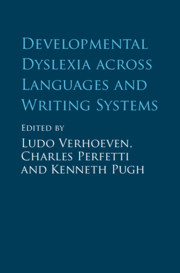Book contents
- Developmental Dyslexia across Languages and Writing Systems
- Developmental Dyslexia across Languages and Writing Systems
- Copyright page
- Contents
- Figures
- Tables
- Contributors
- 1 Introduction
- Part I Developmental Dyslexia across Languages and Writing Systems
- Part II Cross-Linguistic Perspectives on Developmental Dyslexia
- 11 Behavioral Precursors of Developmental Dyslexia
- 12 Neural Predictors of Developmental Dyslexia
- 13 Neurocognitive Markers of Developmental Dyslexia
- 14 Role of Visual Attention in Developmental Dyslexia
- 15 Morphological and Semantic Processing in Developmental Dyslexia
- 16 Modeling the Variability of Developmental Dyslexia
- 17 Modeling Developmental Dyslexia across Languages and Writing Systems
- 18 Etiology of Developmental Dyslexia
- 19 Intergenerational Transmission in Developmental Dyslexia
- Epilogue
- Index
- References
19 - Intergenerational Transmission in Developmental Dyslexia
from Part II - Cross-Linguistic Perspectives on Developmental Dyslexia
Published online by Cambridge University Press: 27 September 2019
- Developmental Dyslexia across Languages and Writing Systems
- Developmental Dyslexia across Languages and Writing Systems
- Copyright page
- Contents
- Figures
- Tables
- Contributors
- 1 Introduction
- Part I Developmental Dyslexia across Languages and Writing Systems
- Part II Cross-Linguistic Perspectives on Developmental Dyslexia
- 11 Behavioral Precursors of Developmental Dyslexia
- 12 Neural Predictors of Developmental Dyslexia
- 13 Neurocognitive Markers of Developmental Dyslexia
- 14 Role of Visual Attention in Developmental Dyslexia
- 15 Morphological and Semantic Processing in Developmental Dyslexia
- 16 Modeling the Variability of Developmental Dyslexia
- 17 Modeling Developmental Dyslexia across Languages and Writing Systems
- 18 Etiology of Developmental Dyslexia
- 19 Intergenerational Transmission in Developmental Dyslexia
- Epilogue
- Index
- References
Summary
Developmental dyslexia is a neurologically based learning disorder that often runs in families (Fisher & DeFries, 2002). This chapter focuses on its intergenerational transmission, which refers to the transfer of traits and behaviors from parents to offspring, including genetic factors and nongenetic factors such as epigenetics and environment. Traditionally, transmission of genomic information (i.e., inheritance of DNA sequence) has been considered to be the key pathway by which behavior, cognitive abilities, character traits, and susceptibility to a disorder are inherited. However, growing evidence suggests that nongenetic factors play important roles in influencing gene function and modifying heritability. Combined, the effects of these factors likely result in the various phenotypes of dyslexia. Delineating the intergenerational transmission patterns of dyslexia provides means to further understand its etiology and may provide insight into early identification and preventive intervention.
- Type
- Chapter
- Information
- Developmental Dyslexia across Languages and Writing Systems , pp. 413 - 438Publisher: Cambridge University PressPrint publication year: 2019
References
- 1
- Cited by



